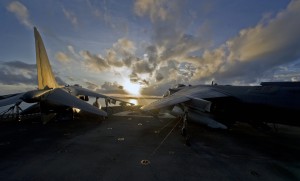2013-03-10 By Col Bradley Weisz, Deputy Commander ESG 2, Joint Expeditionary Base Little Creek, VA
The ARG-MEU is a very flexible instrument.
But as the demand side remains high, and the strategic environment evolves in the 21st century, some changes in operational art are both possible and necessary.
The purpose of this article is to highlight key observations and trends that have been noted from recent East Coast Amphibious Ready Group/Marine Expeditionary Unit (ARG/MEU) deployments to USEUCOM, USAFRICOM and USCENTCOM areas of responsibility (AORs).
The Navy-Marine Corps team continues to excel in providing Combatant Commanders with forces which have unmatched tactical and operational flexibility.
Tightening up just a few processes and procedures in several areas will serve to make the ARG/MEU team even better.
The Growth of Disaggregated, Split and Complex Operations
ARG/MEU training and work-ups (USN FRTP/USMC PTP) consist primarily of aggregated and sequential operations.
Nonetheless, the reality of ARG/MEU deployments has consisted primarily of disaggregated, split and complex operations requiring continuous planning and simultaneous execution. Disaggregated and split operations have become the norm for some time now.
One area of training that requires more attention is the proper coordination and integration of carrier strike group (CSG) operations with ARG/MEU operations, which would decisively bolster the initiation of the recently developed single naval battle concept.

Amphibious Squadrons (PHIBRONs) need to conduct additional training and education in regards to current composite warfare commander (CWC) construct and standards.
Pre-deployment site surveys (PDSSs) to all Combatant Commander areas of responsibility (AORs) are significant enablers for ARG/MEU deployments.
Independent deployment forcers should be afforded the same opportunity to conduct these invaluable PDSSs.
Well-developed and rehearsed pre-planned responses (PPRs) are critical as ARG/MEUs are traditionally the first responders to international crises and contingencies.
A Shift in Personnel Focus
At the same time, ARG/MEUs need “thinking” young officers and enlisted with operational planning backgrounds who can assess situations and plan a way ahead.
Special operations forces (SOF) coordination and integration are becoming more essential for ARG/MEU operations.
Perhaps it is time to permanently assign Marine or Navy SOF personnel in support of all ARG/MEU training, work-ups and deployments.
US Embassy and country team familiarization, cooperation and integration are necessary for successful ARG/MEU operations.
No two ARG/MEU deployments are ever the same. ARG/MEUs showcase their flexibility, versatility and operational agility by continuously conducting missions across the entire spectrum of operations from theater security cooperation to humanitarian assistance/disaster relief to combat operations.
Whether operating from the sea, the land or the air, ARG/MEUs provide unmatched tactical and operational flexibility to Combatant Commanders.
Their uniqueness is that they do not require host nation support, host nation basing rights, over flight rights or status of forces agreements (SOFA).
ARG/MEUs prepare for the unexpected by incorporating regular maintenance periods and stand-downs into their extremely tight schedule of events (SOE).
Big deck amphibious warships (LHDs/LHAs) combined with V/STOL and STOVL aircraft (MV-22Bs, AV-8Bs, future F-35Bs) provide rapid response and immediate effects to the Combatant Commander.
The decision and execution cycle for aviation operations aboard big deck amphibs with V/STOL and STOVL aircraft is just minutes compared to hours for conventional and historic fixed-wing aviation operations provided by component commanders.
Permanent placement of Aviation Combat Element (ACE) aircraft (CH-53Es, H-1s) aboard the SAN ANTONIO class amphibious transport docks (LPDs) has been invaluable when conducting disaggregated and split ARG/MEU operations.
LPDs are truly secondary aviation platforms for the MEU ACE.
However, manning and equipping the SAN ANTONIO Class amphibs is lagging; especially with medical personnel/specialists and aviation ordnance personnel.
A Shift in Operational Training and Support
ISR assets such as Scan Eagle and STUAS are becoming increasingly necessary for ARG/MEU operations; especially given the current CP and A2/AD threat that exists in the littoral environment.
Djibouti and Kuwait provide exceptional training, readiness and sustainment opportunities for the ARG/MEU.
The time is now to initiate more strategic investment in Djibouti while sustaining our operational access to Kuwait.
ACE assault support aircraft such as the KC-130Js, MV-22Bs and CH-53Es are being utilized more frequently for logistical support and sustainment runs for the ARG/MEU.
Increased Combatant Commander theater logistical support is needed in lieu of using strictly MEU ACE assets.
Increased vehicle weights, especially armored HMMWVs, have made debarkation from landing craft utility platforms (LCUs) more dangerous, requiring increased training and safety measures for Marines and sailors.
Dock landing ships (LSDs) are in dire need of C5I upgrades; currently they have no data link capability. These C5I upgrades are required to support more disaggregated and split operations.
Additionally, blue-green administrative requirements have grown and continue to place high demands on band-width that the LSDs (as well as LHDs and LPDs) cannot keep up with.
Theater security cooperation (TSC) and engagement opportunities continue to increase.
There is enhanced focus on smaller scale exercises with much less focus on larger scale exercises.
More nations are requiring Marines and sailors entering their country/territory to possess a passport. Expanding the number of Marines and sailors possessing passports and government travel cards is a must.
Conclusion
Sea-basing continues to provide ARG/MEUs with the necessary afloat “dynamic support” capabilities (logistical support) vice having to push and build that similar capability ashore.
Communications strategy is helpful for supporting ARG/MEU operations. More detailed plans must be implemented and executed throughout the entire training, work-up and deployment phases/cycle for the kind of modern communications necessary in the 21st century.
As our naval services continue to introduce new concepts and technology with our ARG/MEU teams, we must ensure our Combatant Commanders remain fully aware and familiar of the unique capabilities that these sea-based blue-green teams bring to the fight.
Col Bradley E. Weisz is currently assigned as the Deputy Commander, Expeditionary Strike Group TWO, United States Fleet Forces Command, Little Creek, Virginia. His background in the Marine Corps is aviation command and control.

